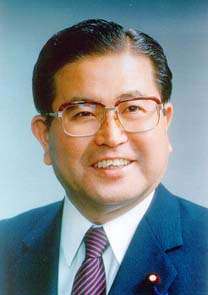Sohei Miyashita
Sohei Miyashita (宮下 創平, Miyashita Sohei, 10 November 1927 – 7 October 2013) was a Japanese politician. He held different cabinet posts.
Sohei Miyashita | |
|---|---|
宮下 創平 | |
 | |
| Minister of Health and Welfare | |
| In office 30 July 1998 – 14 January 1999 | |
| Prime Minister | Keizō Obuchi |
| Preceded by | Junichirō Koizumi |
| Succeeded by | Yuya Niwa |
| Head of the Environmental Agency | |
| In office 14 August 1994 – 8 August 1995 | |
| Prime Minister | Tomiichi Murayama |
| Preceded by | Shin Sakurai |
| Succeeded by | Tadamori Oshima |
| Director-General of the Japan Defense Agency | |
| In office 5 November 1991 – 12 December 1992 | |
| Prime Minister | Kiichi Miyazawa |
| Preceded by | Yukihiko Ikeda |
| Succeeded by | Toshio Nakayama |
| Personal details | |
| Born | 10 November 1927 Ina, Nagano, Empire of Japan |
| Died | 7 October 2013 (aged 85) Tokyo, Japan |
| Political party | Liberal Democratic Party |
Biography
Miyashita was born in 1927.[1] He worked at the Ministry of Finance as a budget examiner.[2] He was a member of the Liberal Democratic Party and served in the House of Representatives for seven terms.[1][3][4] He was appointed Director General of the Japan Defense Agency on 5 November 1991, replacing Yukihiko Ikeda in the post.[5] Miyashita served in the post until 12 December 1992 when Toshio Nakayama succeeded him in the post.[5]
He was appointed Head of the Environmental Agency in the cabinet led by Prime Minister Tomiichi Murayama on 14 August 1994.[1] Miyashita succeeded Shin Sakurai in the post when the latter resigned from office due to his statements about the role of Japan in World War II.[6] In August 1998, Miyashita was appointed minister of health and welfare in the cabinet headed by Prime Minister Keizō Obuchi.[7] Then Miyashita was made chairman of the Liberal Democratic Party's tax panel.[8]
Miyashita died of pneumonia in Tokyo on 7 October 2013.[9]
References
- Rei Shiratori (1996). "Description of Japanese Politics in 1995". European Journal of Political Research. 30. Retrieved 14 October 2013.
- Takao Sebata (5 June 2010). Japan's Defense Policy and Bureaucratic Politics, 1976-2007. University Press of America. p. 208. ISBN 978-0-7618-5082-3.
- "Obuchi names cabinet". Trends in Japan. 31 July 1998. Retrieved 14 October 2013.
- "Coalition cabinet formed". Trends in Japan. 20 January 1999. Retrieved 24 October 2013.
- "Japanese ministries". Rulers. Retrieved 14 October 2013.
- "Briefs". St Louis Post-Dispatch. AP/Reuters. 15 August 1994. Retrieved 14 October 2013. – via Questia (subscription required)
- "Japan's new cabinet lineup". Japan Policy & Politics. 3 August 1998. Retrieved 14 October 2013.
- "Japan to see US$14.6 billion net tax cut". China Daily. Tokyo. 13 December 2002. Archived from the original on 6 November 2013. Retrieved 14 October 2013. – via Highbeam (subscription required)
- "Sohei Miyashita, a former Minister of Health and Welfare death". Uzuzu. Archived from the original on 4 March 2016. Retrieved 14 October 2013.
| House of Representatives of Japan | ||
|---|---|---|
| Preceded by Eiji Nonaka |
Chair, House of Representatives Audit Committee 1988–1989 |
Succeeded by Yasushi Nakamura |
| Political offices | ||
| Preceded by Yukihiko Ikeda |
Head of the Japan Defense Agency 1991–1992 |
Succeeded by Toshio Nakayama |
| Preceded by Shin Sakurai |
Head of the Environmental Agency 1994–1995 |
Succeeded by Tadamori Oshima |
| Preceded by Junichiro Koizumi |
Minister of Health and Welfare 1998–1999 |
Succeeded by Yuya Niwa |